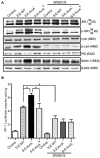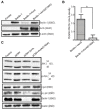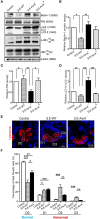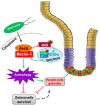Salmonella Enteritidis Effector AvrA Suppresses Autophagy by Reducing Beclin-1 Protein
- PMID: 32362899
- PMCID: PMC7181453
- DOI: 10.3389/fimmu.2020.00686
Salmonella Enteritidis Effector AvrA Suppresses Autophagy by Reducing Beclin-1 Protein
Abstract
Autophagy is a cellular process to clear pathogens. Salmonella enterica serovar Enteritidis (S.E) has emerged as one of the most important food-borne pathogens. However, major studies still focus on Salmonella enterica serovar Typhimurium. Here, we reported that AvrA, a S. Enteritidis effector, inhibited autophagy to promote bacterial survival in the host. We found that AvrA regulates the conversion of LC3 I into LC3 II and the enrichment of lysosomes. Beclin-1, a key molecular regulator of autophagy, was decreased after AvrA expressed strain colonization. In S.E-AvrA--infected cells, we found the increases of protein levels of p-JNK and p-c-Jun and the transcription level of AP-1. AvrA-reduction of Beclin-1 protein expression is through the JNK pathway. The JNK inhibitor abolished the AvrA-reduced Beclin-1 protein expression. Moreover, we identified that the AvrA mutation C186A abolished its regulation of Beclin-1 expression. In addition AvrA protein was found interacted with Beclin-1. In organoids and infected mice, we explored the physiologically related effects and mechanism of AvrA in reducing Beclin-1 through the JNK pathway, thus attenuating autophagic responses. This finding not only indicates an important role of S. Enteritidis effector in reducing host protein as a strategy to suppress autophagy, but also suggests manipulating autophagy as a new strategy to treat infectious diseases.
Keywords: autophagy; effector; infection; organoids; paneth cells.
Copyright © 2020 Jiao, Zhang, Lin, Lu, Xia, Meng, Pan, Xu, Jiao and Sun.
Figures







Similar articles
-
AvrA Exerts Inhibition of NF-κB Pathway in Its Naïve Salmonella Serotype through Suppression of p-JNK and Beclin-1 Molecules.Int J Mol Sci. 2020 Aug 23;21(17):6063. doi: 10.3390/ijms21176063. Int J Mol Sci. 2020. PMID: 32842467 Free PMC article.
-
Salmonella enteritidis Effector AvrA Stabilizes Intestinal Tight Junctions via the JNK Pathway.J Biol Chem. 2016 Dec 23;291(52):26837-26849. doi: 10.1074/jbc.M116.757393. Epub 2016 Nov 15. J Biol Chem. 2016. PMID: 27875307 Free PMC article.
-
AvrA effector protein of Salmonella enterica serovar Enteritidis is expressed and translocated in mesenteric lymph nodes at late stages of infection in mice.Microbiology (Reading). 2014 Jun;160(Pt 6):1191-1199. doi: 10.1099/mic.0.077115-0. Epub 2014 Apr 4. Microbiology (Reading). 2014. PMID: 24705228 Free PMC article.
-
Salmonella Enteritidis RfbD enhances bacterial colonization and virulence through inhibiting autophagy.Microbiol Res. 2023 May;270:127338. doi: 10.1016/j.micres.2023.127338. Epub 2023 Feb 16. Microbiol Res. 2023. PMID: 36854232
-
Autophagy and Ubiquitination in Salmonella Infection and the Related Inflammatory Responses.Front Cell Infect Microbiol. 2018 Mar 14;8:78. doi: 10.3389/fcimb.2018.00078. eCollection 2018. Front Cell Infect Microbiol. 2018. PMID: 29594070 Free PMC article. Review.
Cited by
-
Ubiquitin-Dependent and Independent Proteasomal Degradation in Host-Pathogen Interactions.Molecules. 2023 Sep 21;28(18):6740. doi: 10.3390/molecules28186740. Molecules. 2023. PMID: 37764516 Free PMC article. Review.
-
Myeloid vitamin D receptor regulates Paneth cells and microbial homeostasis.FASEB J. 2023 Jun;37(6):e22957. doi: 10.1096/fj.202202169RR. FASEB J. 2023. PMID: 37219463 Free PMC article.
-
The interplay between Salmonella and host: Mechanisms and strategies for bacterial survival.Cell Insight. 2025 Feb 13;4(2):100237. doi: 10.1016/j.cellin.2025.100237. eCollection 2025 Apr. Cell Insight. 2025. PMID: 40177681 Free PMC article. Review.
-
Current Knowledge about Gastric Microbiota with Special Emphasis on Helicobacter pylori-Related Gastric Conditions.Curr Issues Mol Biol. 2024 May 20;46(5):4991-5009. doi: 10.3390/cimb46050299. Curr Issues Mol Biol. 2024. PMID: 38785567 Free PMC article. Review.
-
SaaS sRNA promotes Salmonella intestinal invasion via modulating MAPK inflammatory pathway.Gut Microbes. 2023 Jan-Dec;15(1):2211184. doi: 10.1080/19490976.2023.2211184. Gut Microbes. 2023. PMID: 37158502 Free PMC article.
References
MeSH terms
Substances
LinkOut - more resources
Full Text Sources
Medical
Research Materials
Miscellaneous

